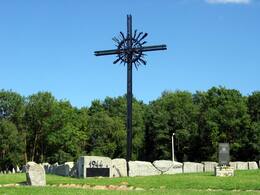Sinimäe (Mėlynųjų kalvų) mūšis
Šis mūšis turi platesnę ideologinę prasmę. „Tai buvo pirmas atvejis po Estijos okupacijos 1940 m., kai estai demonstravo tokio masto pasipriešinimą Raudonajai armijai“, – sako istorikas Toomas Hiio iš Estijos karo istorijos muziejaus. „Daugiausiai tai lėmė troškimas atkeršyti. Taip buvo pavaizduota karo propaganda, tačiau propagandą dažniausiai išveda iš to, kas iš tikrųjų vyksta. batalionai vienas valdė frontą, dar 2005 m. parašiau straipsnį, kuriame nusprendžiau, kad kadangi vokiečiai dalį savo pajėgų perkėlė į kritiškesnį Baltarusijos frontą, dalį – į Suomiją, 1944 m. liepos mėn. pusė pėstininkų buvo estai. Tačiau pėstininkai nebuvo vieni: buvo ir artilerijos, specialiųjų pajėgų ir daug kitų.
https://pohjarannik.postimees.ee/6594548/ainuke-paik-kus-punaarmee-1944-aastal-kuudeks-seisma-pandi
Susijusios vietos
Sinimägede (Blue Hills) battlefield memorial
This memorial is situated on the western slope of Grenaderimägi Hill in the Blue Hills near the old Vaivara cemetery.
It symbolises the battle fought in the Blue Hills during World War II between Soviet and German forces.
The first monument in the Blue Hills area – a 6.5-metre wooden cross – was erected here in 1994. The current memorial was completed in 2000. The 12-metre steel cross, which towers over a hectare of land, was designed by artist and blacksmith H. Müller. In the middle of the cross is a composition depicting an explosion. In 2004, a monument in honour of the 20th Waffen Grenadier Division was added to the memorial. Two years later, monuments commemorating the Dutch and Walloon volunteers who fought alongside the Estonians were added.
Grenaderimägi Hill regularly changed hands from one battle to the next. The last point of defence, known as the ‘Hellhole’, was around 100 metres to the east of the memorial cross.





